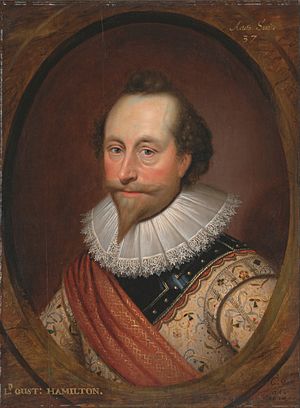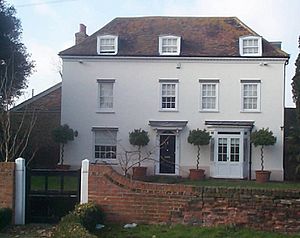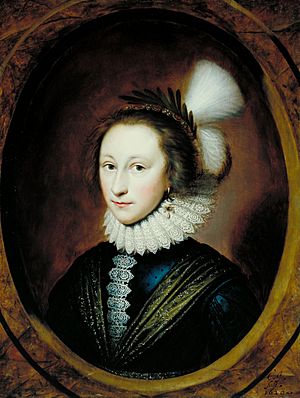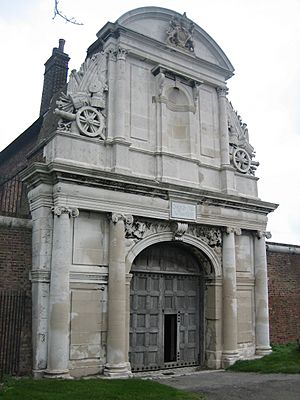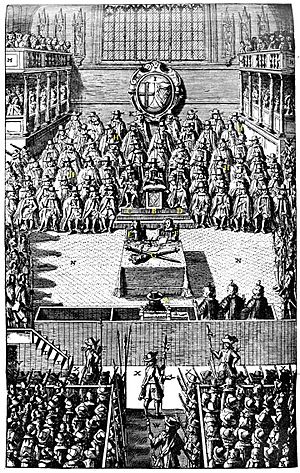James Temple facts for kids
Quick facts for kids
James Temple
|
|
|---|---|
| Born | c. 1606 |
| Died | 17 February 1680 |
| Spouse(s) | Mary Busbridge (married 1627) Joanna van Tromp |
| Children | John (bef 1629) Alexander (1629) James (1630) Thomas (1631) Mary (1632) Peter (1633) |
| Parent(s) | Sir Alexander Temple Mary Sommer |
James Temple (1606–1680) was an English soldier and politician during a very important time in England's history. He was a puritan, which meant he had strong religious beliefs. He fought in the English Civil War and later became one of the judges who decided the fate of King Charles I.
Born in Rochester, Kent, James came from a well-known family. He gained military experience early in his life. When the Civil War began, he joined the Parliamentary army. He became a colonel and was in charge of Tilbury Fort, an important defense near London. He was chosen to be a Member of Parliament (MP) for Bramber. After the war, he was involved in the trial of King Charles I. He was later imprisoned on Jersey where he died.
Contents
Who Was James Temple?
Early Life and Family Background
James Temple was born in Rochester, Kent. His parents were Sir Alexander Temple and Mary Sommer. His family was part of the gentry, which meant they had a good income and social standing, but they were not part of the highest nobility. His father, Sir Alexander, was knighted by King James I.
James had an older brother named John and a sister named Susan. He also had two half-brothers and two half-sisters from his mother's first marriage. His family had many important connections. His uncles included Sir Thomas Temple, 1st Baronet, of Stowe and William Fiennes, 1st Viscount Saye and Sele. His sister, Susan Temple, was the grandmother of Sarah Churchill, Duchess of Marlborough, a very famous person later on.
In 1607, after his mother passed away, James moved with his father to Longhouse Place in Chadwell St Mary, Essex. Both James and his brother John studied law at Lincoln's Inn in 1622. That same year, James was allowed to travel abroad for up to three years, but he was not allowed to visit Rome.
While living in Chadwell St Mary, several family portraits were painted by Cornelius Johnson. These included paintings of James's father and sister. It's possible James was painted too, but no portrait of him from that time has survived.
In the early 1620s, James moved again, this time to Haremere Hall in Etchingham, Sussex. This move happened after his father married Mary Bankworth. James later married his stepsister, Mary Busbridge, in March 1627. They had six children together.
Military Experience: Isle of Ré Expedition
In June 1627, James Temple joined a military trip led by the Duke of Buckingham. This trip was to the island of Île de Ré to help French Protestants called Huguenots. Many volunteers joined because they supported the Huguenots. James, his older brother John, and other family members went along.
However, this trip was a disaster. Buckingham's forces lost more than 5,000 men. Sadly, James's brother John was among those who died.
Life in Sussex Before the War
When James's father died in 1629, James inherited his estate. However, much of the property was tied up or used for other purposes, so James didn't inherit a huge fortune. He didn't get a grand country house or a large estate. His financial situation was not very good, and other family members discussed it.
During King Charles I's Personal Rule (1629–1640), when the King ruled without Parliament, James was part of a group of Puritan gentry in Sussex. He later became a justice of the peace (JP), helping to keep order and enforce laws in his area.
The English Civil War
James Temple, like many in his family, was a puritan and supported Parliament against the King. His uncle, Lord Saye and Sele, was a strong opponent of the King. James's military experience became very useful when the First English Civil War started in August 1642.
He was made a captain of a cavalry troop led by his cousin, John Fiennes. James was also related to Oliver Cromwell, a very important leader for Parliament. James fought at the Battle of Edgehill in October 1642, which was a major early battle of the war.
James also took part in the Battle of Bramber Bridge in December 1643. He was appointed by Parliament to a committee in Sussex that managed the property of Royalists (those who supported the King). In December 1643, James played a key role in defending the crossing of the River Adur at Bramber Castle against a Royalist attack. A witness described him as a "brave soldier" with a "head full of stratagems" and a "heart full of piety and valour."
As the war continued, James was promoted to colonel. He became the governor of Tilbury Fort in Essex. This fort was very important because it controlled the river approach to London. During the Second English Civil War, when there were Royalist uprisings, James's control of Tilbury Fort allowed Lord Fairfax's troops to cross the river. This helped Parliament's army during the Siege of Colchester.
Trial of King Charles I and the Commonwealth
In September 1645, James Temple became a Member of Parliament (MP) for Bramber. He was part of a group called the Independents, who did not want to make any compromises with the King. Because of this, he was one of the MPs allowed to stay in Parliament after Pride's Purge. This was a military action that removed many MPs who were not seen as loyal to the Army.
In January 1649, the army and the Independents decided to put King Charles I on trial. James Temple was chosen as one of the judges for this important trial. He attended many court sessions and agreed with the guilty verdict. He was the 28th of 59 judges to sign the King's death warrant.
After the King's execution, during the time known as the Commonwealth, James continued to serve on Parliamentary committees. However, he faced accusations of corruption. In September 1650, these accusations led him to leave his post at Tilbury Fort. Around this time, he likely married his second wife, Joanna van Tromp.
James also faced other accusations about his financial dealings, though nothing was fully proven. For example, he was accused of not returning property deeds he had acquired after arranging for his son to marry a young woman he was guardian of.
After the Monarchy Returned
When King Charles II returned to power in 1660, this event was called the Restoration. James Temple was not included in the Indemnity and Oblivion Act, which offered forgiveness to many who had opposed the King. This was because of his role in the trial and execution of Charles I.
He was caught in Warwickshire while trying to travel to Ireland. He was held in the Tower of London and then put on trial. He tried to avoid being executed by saying he had only acted as a judge to help the Royalists and that he had begged Oliver Cromwell to spare the King. He was not executed but was sentenced to life imprisonment.
For security reasons, James and other judges were sent to Jersey in the Channel Islands. He was first held in Mont Orgueil and later in Elizabeth Castle. He is believed to have died there on 17 February 1680.
A writer named William Winstanley described James Temple as someone "remarkable for nothing but this horrible business of the king's murther."
Images for kids


